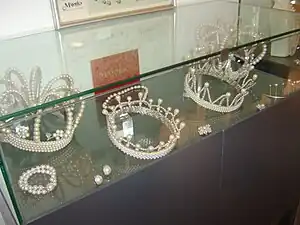Imitation pearl
Imitation pearls are man-made faux pearls. They are not to be confused with cultured pearls, which are real pearls created through human intervention.

Items made from Majorica pearls, a version of imitation pearl
Materials used to create imitation pearls include glass, plastic, and mollusc shells. As an alternative, some plastic beads are coated with a pearlescent substance to imitate the natural iridescence of nacre or mother of pearl.
Types
- Bathed pearl (also called Angel, Sheba, Mikomo, Kobe, Nikko, Sumo, Fijii, Aloha, or "improved cultured pearl") is a mother-of-pearl core coated with a mixture of plastic enamel, lead carbonate, mica, and titanium dioxide, then with a film of iridescent nylon.[1]
- Bohemian pearl is a cut and buffed mother-of-pearl protuberance.[1]
- Cotton pearl (also called "Utter Ethical pearl") is made merely from cotton and mica.
- Glass pearl is a glass bead dipped or sprayed with pearlescent material, or hollow glass bead filled with pearlescent material. One variation is the Majorica pearl. Wax-filled pearl simulants are hollow glass beads coated with essence d'orient and filled with wax. Variations of these wax-filled simulants, which are produced in slightly different manners, include Parisian pearls, Paris pearls, French pearls, Bourguignon pearls, and Venetian pearls.[1]
- Mother-of-pearl pearl is crushed nacreous shell powder, sintered into the desired shape. See also shell pearl (1) below.[1]
- Plastic pearl has plastic core coated with a pearlescent material.[1]
- Roman pearl is an alabaster core coated with a pearlescent material.[1]
- Shell pearl
- Cut, buffed, and sometimes dyed nacreous portions of mollusk shells: Variations and alternate names include cat's-eye pearl, coque de perle (from nautilus shells), mother-of-pearl pearl (from mother-of-pearl), and hinge pearl (from the hinge of bivalve shells).[1]
- Spherical shell core coated with pearlescent material[1]
The pearlescent substance used to coat various cores may contain essence d'orient, isinglass, fish scales, oyster scales, or mother-of-pearl powder, along with binders or dyes.[1]
Coral is sometimes used to imitate pearls from the pink conch, and hematite is sometimes used to imitate black pearls.[1]
See also
References
- "Pearls". stoneplus.cst.cmich.edu.
This article is issued from Wikipedia. The text is licensed under Creative Commons - Attribution - Sharealike. Additional terms may apply for the media files.